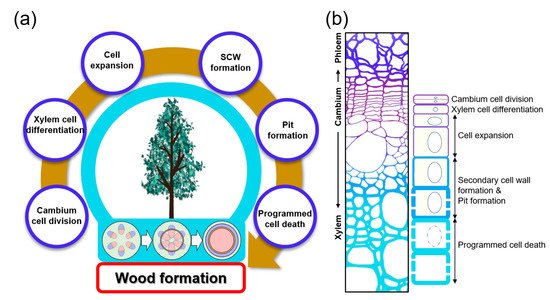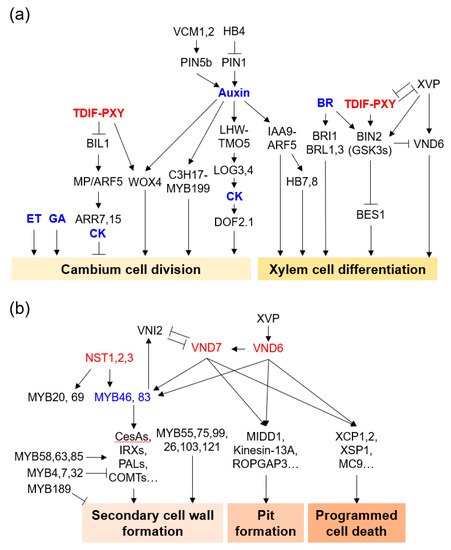Your browser does not fully support modern features. Please upgrade for a smoother experience.
Please note this is an old version of this entry, which may differ significantly from the current revision.
Subjects:
Biochemistry & Molecular Biology
Unlike herbaceous plants, woody plants undergo volumetric growth (a.k.a. secondary growth) through wood formation, during which the secondary xylem (i.e., wood) differentiates from the vascular cambium. Wood is the most abundant biomass on Earth and, by absorbing atmospheric carbon dioxide, functions as one of the largest carbon sinks. As a sustainable and eco-friendly energy source, lignocellulosic biomass can help address environmental pollution and the global climate crisis.
- woody plant
- biomass
- secondary growth
- wood formation
- cambium
- xylem
1. Introduction
Land plants can be divided into two main groups: vascular and non-vascular plants. The vascular system is one of the key factors that enabled plants to successfully settle on land about 470 million years ago. The vascular system not only transports water, nutrients, and signals throughout the plant but also serves as mechanical support that maintains the plant’s vertical growth, increasing access to sunlight. The secondary xylem consists of vessel, fiber, and tracheid cells, with a thick secondary cell wall (SCW) composed mainly of cellulose, hemicellulose, and lignin [1,2,3]. The secondary xylem is derived from the vascular cambium, which is a cylindrical secondary meristem. Wood formation is achieved through a series of cascading processes that include: xylem mother cell specification by vascular cambium cell division, the differentiation of these cells into xylem cells followed by cell expansion, secondary cell wall deposition, pit formation, and programmed cell death (Figure 1). Each step is elaborately coordinated by factors such as hormones, signal peptides, and transcription factors (TFs). Recently, due to the global climate crisis, interest in sustainable energy development using eco-friendly and renewable biomass is increasing. Woody biomass produced from wood formation processes offers an economic and sustainable feedstock for bioenergy production.

Figure 1. Wood formation in plants. (a) Simplified process of wood formation. Wood formation is initiated through cell divisions within the cylindrical vascular cambium layer, formed from the procambium. Then xylem cell differentiation, cell expansion, secondary cell wall (SCW) and pit formation, and programmed cell death (PCD) follow. Vascular cambium formation from procambium is shown in the stem cross-sections from below a tree: xylem (red), phloem (blue), and the cambium (yellow). (b) Stem cross-section and cell diagram for each stage of wood formation. The xylem is formed through the vascular cambium cell division and xylem cell differentiation, cell expansion, secondary cell wall formation and pit formation, and programmed cell death.
2. Vascular Cambium Cell Development and Xylem Cell Differentiation: Initiating Wood Formation
The growth and development of woody plants can be largely divided into primary and secondary phases. Primary growth occurs in the shoot apical meristem (SAM) within the ground and root apical meristem (RAM) in the basement. In the apical region of this meristem tissue, the procambium differentiates into primary phloem and primary xylem that comprise the primary vascular bundle. As the procambium expands to the interfascicular region, it develops into a ring to form vascular cambium [4]. Secondary growth refers to the production of wood by the vascular cambium. Vascular cambium divides to produce daughter cells, with secondary xylem formed toward the center and secondary phloem on the outside of the plant. Xylem mother cells can differentiate into several types of daughter cells. However, it is unknown how the cambium develops and how cell fate is determined via the cambium to the secondary xylem or secondary phloem.
Recently, considerable progress has been made in understanding the molecular mechanisms of cambium formation and development, based on research conducted in model plants such as Arabidopsis and poplar. These studies have revealed that cambium development is regulated by hormones, TFs, and signal peptides [5,6,7,8] (Figure 2a). A series of studies on the functional characteristics of Arabidopsis and poplar mutant plants have revealed genes that play an important role in the development of vascular cambium.

Figure 2. Molecular regulatory network of xylem cell formation. (a) Vascular cambium cell division and xylem cell differentiation. (b) Secondary cell wall formation, pit formation, and programmed cell death in xylem cell formation. Representative genes were depicted with hormones (blue). Genes with essential roles are described in the text.
2.1. Regulation by Plant Hormones
Hormones control various functions such as plant growth, development, and stress resistance [9]. Many studies have reported that vascular cambium activity is regulated by several hormones, including auxins, cytokinins, ethylene, and brassinosteroids.
Auxins are hormones that function in plant growth and development and affect cellular processes such as cell division, expansion, and differentiation [10,11]. Auxins are highly expressed in the cambium cell layer and play an important role in vascular cambium initiation and development [12,13,14,15,16]. PtoIAA9 and AUX/IAA in Populus tomentosa interact with AUXIN RESPONSE FACTOR 5 (PtoARF5) to regulate vascular cambium cell division and secondary xylem development. Auxin signaling maximum leads to direct activation of CLASS III HOMEODOMAIN-LEUCINE ZIPPER III (HD-ZIP III) TFs and changes in cell type-specific transcriptomes that define xylem cell identities [16,17]. The PtoIAA9-PtoARF5 module can bind to the promoter of the HD-ZIP III genes PtoHB7 and PtoHB8, which are involved in secondary xylem formation [18]. When the poplar HD-ZIP III gene PtrHB4 was upregulated, cambium development was induced by enhanced expression of PtrPIN1 [19]. The auxin-responsive module PaC3H17-PaMYB199 is associated with cambium cell division in poplar stems [20]. Knockdown mutants of two Populus MADS-box genes (VCM1 and VCM2), which are modulators of auxin homeostasis specifically expressed in the vascular cambium, enhanced vascular cambium proliferation activity and subsequent xylem differentiation [21].
Cytokinins (CKs) play important roles in vascular cambium development together with auxins. Poplar cytokinin receptor genes HISTIDINE KINASE 3 (PtHK3a) and PtHK3b are expressed at high levels in dividing cambium cells [22]. Inhibition of CK signaling by expression of Arabidopsis AtCKX2 under the promoter of the birch CRE1 gene reduced the number of cambium cells, whereas an increase in CK biosynthesis by expression of Arabidopsis ISOPENTENYL TRANSFERASE 7 (IPT7) increased cambium cell division in transgenic poplars [14,22]. Auxin-regulated LONESOME HIGHWAY (LHW) and TARGET OF MONOPTEROS5 (TMO5)/TMO5-LIKE1 (T5L1) directly up-regulated the CK biosynthesis genes LONELY GUY3 (LOG3) and LOG4, which are involved in the activation of vascular cell division [23]. AT2G28510/DOF2.1, which is a CK-dependent downstream target gene of LHW-TMO5/T5L1, controls vascular cell proliferation [24].
Brassinosteroids (BRs), ethylene (ET), and gibberellins (GAs) also promote vascular cambium division and secondary growth in trees. Mutations of both BRI-LIKE 1 (BRL1) and BRL3, which are Arabidopsis vascular-specific BR receptors, resulted in reduced xylem formation and increased phloem development [25]. BRI1-EMS SUPPRESSOR 1 (BES1) was shown to be involved in xylem differentiation downstream of TDIF-TDR-GSK3s signaling [26]. Similarly, inhibition of BR synthesis resulted in decreased secondary xylem differentiation and SCW biosynthesis, whereas increased BR levels increased secondary growth in poplar [27]. Exogenous BR treatment or genetic complementation of the BR biosynthesis DWARF gene in BR-biosynthetic-mutant tomato with retardation of xylem development resulted in a complete recovery of xylem cell formation [28]. In contrast, overexpression of GLYCOGEN SYNTHASE KINASE 3 (SlGSK3) or CRISPR/Cas9 knockout of BRASSINOSTEROID-INSENSITIVE 1 (SlBRI1) to block BR signaling resulted in severely defective xylem differentiation and secondary growth in tomato [28]. The tonoplast membrane-localized auxin efflux carrier WALLS ARE THIN1 (SlWAT1) is directly activated by SlBRL1/2 in xylem precursor cells. Transposable element (TE)-mediated loss-of-function allele Slwat1-copi resulted in defects in secondary xylem development, with a reduced vessel element number in tomato. Secondary xylem formation of Slwat1-copi was completely recovered by genetic complementation of WAT1 function [29]. Cambium division was increased in ET-overproducing poplar, whereas it was decreased in ET-insensitive poplar [30]. acs7-d, an ET overproducing Arabidopsis mutant, showed enhanced cambial activity and reduced fiber cell wall development [31]. Transgenic poplar overexpressing the GIBBERELLIN 20 OXIDASE 1 (GA20ox1) gene, which is involved in GA biosynthesis, was characterized by GA overproduction and cambium proliferation [32,33,34]. GA also induced vascular cambium differentiation and lignification when expressed downstream of WOX14 in Arabidopsis stems [35,36].
2.2. Regulation by Transcription Factors and Signal Peptides
Regulation via TFs and signal peptides is essential for vascular cambium development and xylem differentiation. CLAVATA3/EMBRYO SURROUNDING REGION (CLE) family peptides are 12–13 amino acids with two hydroxylated proline residues after processing and post-translational modifications [37]. CLE41/44 (a.k.a. TRACHEARY ELEMENT DIFFERENTIATION INHIBITORY FACTOR [TDIF]) is secreted by developing phloem cells and binds to the cambium cell receptor PHLOEM INTERCALATED WITH XYLEM (PXY) [38]. The TDIF-PXY module plays an important role in maintaining the cambium cell population via cell division and inhibiting xylem cell differentiation [39,40]. WUSCHEL HOMEOBOX RELATED 4 (WOX4), a downstream transcriptional regulator of the TDIF-PXY module, is specifically expressed in the cambium region, and is involved in the regulation of cambium activity [38,39,40,41,42]. Ectopic expression of PttCLE41b and other related PttCLE41-like genes causes a dwarf phenotype with loss of cell division orientation and defects in the patterning of vascular tissues [42]. PtrCLE20 is expressed in xylem tissues and suppresses cambium activity in poplar [43]. Populus WOX4, PttWOX4, is specifically expressed in the cambial region during the growing season only. PttWOX4a/b RNAi transgenic poplar showed reduced vascular cambium width and secondary growth [42]. Auxin-dependent WOX4 regulation is achieved in xylem precursor cells with auxin maxima, which promote vascular cambium cell division in a non-cell-autonomous manner [16]. GLYCOGEN SYNTHASE KINASE3/SHAGGY-LIKE KINASE proteins (GSK3s), including ARABIDOPSIS BRASSINOSTEROID-INSENSITIVE2 (BIN2), BIN2-LIKE1 (BIL1), and BIL2 are downstream of the TDIF-PXY module and inhibit xylem differentiation via the suppression of BRI1–EMS–SUPPRESSOR1 (BES1) and BRASSINAZOLE RESISTANT 1 (BZR1) [26,44]. BIL1 is a key mediator linking the TDIF-PXY module with auxin-CK signaling for the maintenance of cambium activity [45]. BIL1 phosphorylates and activates MONOPTEROS/AUXIN RESPONSE FACTOR 5 (MP/ARF5), and activated MP promotes the expression of the CK signaling negative regulators ARABIDOPSIS RESPONSE REGULATOR 7 (ARR7) and ARR15, which suppress cambium cell division.
HD-ZIP III and NAC (NAM, ATAF and CUC) TFs have been reported to play important roles in wood formation. PopREVOLUTA, the closest poplar homolog gene to Arabidopsis REVOLUTA (REV), has been reported to be involved in vascular cambium initiation [46]. Poplar PtrHB5 and PtrHB7, which are the closest homologs of Arabidopsis CORONA and AtHB8, induce cambium activity and xylem differentiation during secondary growth [47,48]. PtrHB7 is preferentially expressed in cambium tissues and is a direct target of the PtrIAA9-PtrARF5 module, inducing cambium activity and xylem differentiation [18,47,48]. PtrHB4 is specifically expressed in shoot tips and in the early developmental stages of vascular tissue; PtrHB4-SRDX (PtrHB4 repressor) transgenic poplar showed defects in the secondary vascular system due to failure of interfascicular cambium formation [19].
The NAC TF family have a highly conserved N-terminal NAC domain, which is associated with nuclear localization, DNA binding, and homodimer and/or heterodimer formation with other NAC proteins [49]. Among the NAC TFs in Arabidopsis, VASCULAR-RELATED NAC DOMAINs (VNDs) are master regulators of xylem differentiation [50,51]. NAC SECONDARY WALL THICKENING PROMOTING FACTOR 1 and 3 (NST1 and 3) are involved in stem fiber differentiation [52,53]. VND1, VND2, and VND3 contribute to xylem vessel formation during seedling development [54]. Poplar VNDs and NST1/3 are also involved in xylem differentiation [55,56,57]. VND6 and VND7, in particular, have been studied as master switches of xylem differentiation in metaxylem and protoxylem cells, respectively [50,58,59]. VND6 and VND7 upregulate xylem vessel cell differentiation-related genes such as SCW biosynthesis genes and programmed cell death (PCD) genes [58,60,61,62]. VND6 and VND7 directly regulate MYB46 and MYB83, which are master regulators of SCW biosynthesis [63,64]. XYLEM DIFFERENTIATION AND ALTERED VASCULAR PATTERNING (XVP) is a negative regulator of the TDIF-PXY module and fine-tunes TDIF signaling for xylem differentiation via interacting with the PXY-BAK1 (BRI1-ASSOCIATED KINASE 1) receptor complex [65].
This entry is adapted from the peer-reviewed paper 10.3390/genes13071181
This entry is offline, you can click here to edit this entry!
